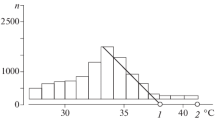Summary
The rate of body temperature change was determined as lizards,Dipsosaurus dorsalis, were heated and cooled between 20 and 40 ° C, at various ambient water vapor pressures (WVP). While changes in WVP did not affect the rate of cooling, the rate of temperature change during heating increased exponentially with increasing WVP (Fig. 4). The ratio of the rate of body temperature change during cooling to the rate of change during heating was reduced 48% in dead animals and 36% in live animals by increasing the WVP during heating from 8 to 47 mm Hg (Fig. 5).
The implication of these observations for studies of physiological thermoregulation in reptiles is discussed.
Similar content being viewed by others
References
Bartholomew, G. A., Lasiewski, R. C.: Heating and cooling rates, heart rate and simulated diving in the Galapagos marine iguana. Comp. Biochem. Physiol.16, 573–582 (1965).
Bartholomew, G. A., Tucker, V. A.: Control of changes in body temperature, metabolism, and circulation by the agamid lizard,Amphibolurus barbatus. Physiol. Zool.36, 199–218 (1963).
Bartholomew, G. A., Tucker, V. A.: Size, body temperature, thermal conductance, oxygen consumption, and heart rate in Australian varanid lizards. Physiol. Zool.37, 341–354 (1964).
Bartholomew, G. A., Tucker, V. A., Lee, A. K.: Oxygen consumption, thermal conductance, and heart rate in the Australian skink,Tiliqua scincoides. Copeia1965, 169–173 (1965).
Dawson, W. R.: Interspecific variation in physiological responses of lizards to temperature. In: Lizard Ecology: A Symposium, Milstead, W. W. (ed.). Columbia, Mo.: Univ. of Missouri Press, 1967.
Murrish, D. E., Schmidt-Nielsen, K.: Exhaled air temperature and water conservation in lizards. Respir. Physiol.10, 151–158 (1970).
Schmidt-Nielsen, K., Dawson, W. R.: Terrestrial animals in dry heat: desert reptiles. In: Handbook of physiology, sect. 4: Adaptation to the environment. Dill, D. B. (ed.). Washington, D. C.: Amer. Physiol. Soc. 1964.
Spray, D. C., May, M. L.: Heating and cooling rates in four species of turtles. Comp. Biochem. Physiol.41A, 507–522 (1972).
Templeton, J. R.: Respiration and water loss at higher temperatures in the desert iguana,Dipsosaurus dorsalis. Physiol. Zool.33, 136–145 (1960).
Templeton, J. R.: Reptiles. In: Comparative physiology of thermoregulation. Whittow, G. C. (ed.). New York: Academic Press 1970.
Weathers, W. W.: Physiological thermoregulation in the lizardDipsosaurus dorsalis. Copeia1970, 549–557 (1970).
Weathers, W. W.: Some cardiovascular aspects of temperature regulation in the lizardDipsosaurus dorsalis. Comp. Biochem. Physiol.40A, 503–515 (1971).
Weathers, W. W., White, F. N.: Physiological thermoregulation in turtles. Amer. J. Physiol.221, 704–710 (1971).
Author information
Authors and Affiliations
Additional information
This paper is part of a dissertation submitted in partial fulfillment of the requirements for the Ph. D. degree at the University of California, Los Angeles.
This study was completed under the guidance of the late Robert C. Lasiewski, to whom I am deeply indebted. Marvin H. Bernstein, Harvey B. Lillywhite and Larry Redekopp contributed valuable suggestions, and Gregory K. Snyder criticized the manuscript and generously offered numerous suggestions. This study was supported in part by funds from National Science Foundation Grants GB-3017 and GB-5347 to R. C. Lasiewski and U.S. Public Health Service Training Grant HE-5166.
Rights and permissions
About this article
Cite this article
Weathers, W.W. Influence of water vapor pressure on the apparent capacity for physiological thermoregulation in reptiles. J. Comp. Physiol. 81, 301–308 (1972). https://doi.org/10.1007/BF00693634
Received:
Issue Date:
DOI: https://doi.org/10.1007/BF00693634




